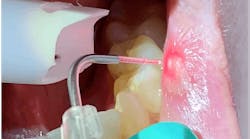Jeffrey D. Hillman, DMD, PhD, founded Oragenics, Inc., to commercialize the fruits of 25 years of research at the Harvard-affiliated Forsyth Institute in Boston and the University of Florida. Currently a professor emeritus at the University of Florida, College of Dentistry, Dr. Hillman has continued his work at Oragenics on final development of several cutting-edge health technologies. Dr. Hillman has authored or co-authored more than 125 publications and textbook chapters on subjects related to the etiology and prevention of caries (cavities), periodontal (gum) diseases, and other infectious diseases and cancer. Dr. Hillman received his undergraduate training at the University of Chicago, his DMD degree from the Harvard School of Dental Medicine, and his PhD from Harvard Medical School.References
1. Van Dyke TE. The management of inflammation in periodontal disease. J Periodontol 2008; 79:1601-1608.2. Paraskevas S, Hulzinga J, Loos B. A systemic review and meta-analysis on C-reactive protein in relation to periodontitis. J Clin perio 2008; 35:277-290.3. Socransky SS, Haffajee AD. The nature of periodontal diseases. Ann Periodontol 1997; 2:3-10.4. Hillman JD, Socransky SS. The theory and application of bacterial interference to oral diseases. In New Biotechnology in Oral Research. Ed. Myers HM (Basel: S Karger) 1989; 1-17.5. Zahradnik RT, Magnusson I, Walker C, Mcdonnell E, Hillman CH, Hillman JD. Preliminary assessment of safety and effectiveness in humans of ProBiora3, a probiotic mouthwash. J Applied Micro 2009; 107:682-690.6. Hillman JD, McDonnell E, Hillman CH, Zahradnik RT, Soni MG. Safety assessment of ProBiora3, a probiotic mouthwash; subchronic toxicity study in rats. Int’l J Toxicology 2009; 28:357-367.
By Jeffrey D. Hillman, DMD, PhDOral-systemic connectionRecent research confirms that a connection exists between periodontal or gum disease and a host of systemic problems, including heart disease, stroke, diabetes, and some forms of cancer.1 While the strength of these correlations is currently the focus of considerable research, the exact mechanism of the link between these diseases is not certain, and this has led to some controversy as to whether the association is causal or casual. Those dental researchers who promote a causal relationship between gum disease and other systemic diseases suggest that this link likely relates to oral plaque build-up, especially under the gums. The resultant chronic inflammation from oral plaque can then contribute to the total systemic inflammatory burden. Other scientists, however, propose that there is merely a casual relationship,2 and that there are common causal factors for both periodontal disease and other systemic outcomes, including such lifestyle factors as smoking, diet, alcohol, and certain medications. The dental health status, therefore, may be predictive of systemic health simply because a lifestyle that is harmful for teeth and gums is very likely harmful for general health.The question of causal vs. casual link will likely be answered in the coming years as more evidence accumulates from well-designed clinical trials and epidemiological studies. Regardless of which position eventually proves to be true, however, controlling inflammation in any part of the body represents a sensible treatment goal for the dental community. In dental practice, the control of oral inflammation typically involves the use of mechanical or chemical means to remove plaque as the causative agent of this localized inflammation. Also, whatever the nature of this link, dentists should routinely discuss healthy lifestyle choices with their patients to improve not only their oral health, but their overall health as well. Traditional approaches to plaque controlPeriodontal disease is among the most common chronic infectious diseases worldwide. Current periodontal therapy is basically designed to disinfect the existing periodontal pockets by aggressively removing the bacterial load around and below the gum line. Current methods typically include scaling and root planning (SRP) the four quadrants using an ultrasonic scaler or hand instrumentation to remove calculus and microbial biofilms. Often SRP is followed by simple pocket irrigation with a strong antibacterial agent or the use of a controlled delivery device for local application of antimicrobials, such as the professionally available products PerioChip, Arestin, or Atridox.Despite best efforts by dental professionals to sterilize the periodontal pockets and remove any source of localized inflammation, the pockets will inevitably repopulate with oral bacteria. There is a significant body of clinical research which suggests that, following periodontal therapy, the earliest colonizers of the sterilized pockets strongly relate to the clinical outcome of the therapy,3 so that the long-term success of the therapy correlated well with the specific types of bacteria that initially repopulated the treated site. If certain viridians streptococci are the initial colonizers, it was reported that these species promoted long-term periodontal health, most likely by inhibiting the recolonization or outgrowth of microorganisms in the treated sites capable of reinitiating periodontal disease. The studies also showed that an unchecked overgrowth of certain putative pathogenic bacteria in the periodontal pocket resulted in more severe localized inflammation and further tissue breakdown. With the recognized oral-systemic link, such a poor therapeutic outcome could potentially portend systemic health problems for that individual.Novel approach to plaque controlBacteria are normal inhabitants of humans, and the oral cavity itself provides an ecological niche for more than 700 microbial species. The vast majority of these oral species are referred to as commensal species, indicating that they do no harm to the host. A small number of species, however, can cause a shift from oral health when they are able to achieve sufficiently large numbers in localized areas of the teeth and gums. In contrast, it has been determined that a small number of species can actually help maintain a microflora balanced in favor of health.4 An interesting approach to controlling the harmful effects of oral plaque build-up and the subsequent development of localized inflammation, therefore, may be to augment the host with these beneficial bacteria that are normally responsible for maintaining that healthful balance of oral microflora. Beneficial bacteria can help to maintain a healthy microbial balance in a variety of ways; for example, through the production of specific metabolites that are antagonistic to the putative pathogenic microorganisms, or by competition with them for essential nutrients and attachment sites in the oral cavity.Probiotics for oral careThe term “probiotics” occurs with regularity in the lay press and is traditionally defined as live microorganisms which, when administered in adequate amounts, confer a health benefit on the host. I began my basic research into controlling the balance of good bacteria in dental plaque in the late 1970s at the Harvard-affiliated Forsyth Institute in Boston, and then transferred my research to the University of Florida, College of Dentistry, in 1992. The extensive research conducted at these dental institutions convinced me that a few key naturally occurring oral bacteria can act as antagonists to potentially harmful bacteria that are very frequently present in the human mouth. In 1996, I formed a company called Oragenics to commercialize the scientific discoveries resulting from more than 25 years of research into oral biology. As a result of significant product development efforts at Oragenics over the past several years, in late 2008 our company launched a new product, ProBiora3®, based on a proprietary blend of three select oral bacterial strains of human origin. This probiotic blend consists of Streptococcus oralis strain KJ3 and Streptococcus uberis strain KJ2 for maintaining gingival health, and Streptococcus rattus strain JH145 for maintaining dental health. A clinical trial demonstrated that twice-daily rinsing with this blend of naturally occurring oral bacteria cultures was able to substantially decrease the numbers of key, potentially pathogenic bacteria in the mouths of young, healthy adults over a period of four weeks.5 In addition to helping maintain a healthy balance of bacteria on tooth and gingival surfaces, oral care products containing ProBiora3 have further been shown to gradually whiten dental surfaces due the natural production of low levels of hydrogen peroxide by these strains, and to help to freshen breath by suppressing the oral bacterial species associated with malodor.Logically, microorganisms that normally colonize the teeth or gums are going to be best suited to serve as oral probiotics. There have been reported attempts to utilize bacteria for oral care that normally colonize the intestinal mucosa rather than adhere to dental tissues as part of the recognized biofilm or plaque. An important element for long-term oral care benefits, therefore, requires that any selected strain be indeed “an oral probiotic.” Further, the selected strains must also be shown to be safe, especially at the recommended dosage level, and the strains should not contain any resistance factors to commonly used antibiotics. The safety of ProBiora3 strains has been well-established for oral application.6 Finally, any clinical trials used for the selection of strains, for the identification of the mechanism(s) of action, and for supporting any oral care claims must be well-designed, and the results of such studies should be published in peer-reviewed journals. As an example, some published clinical reports rely on microbiological analysis of saliva samples to demonstrate changes in oral plaque composition; such an approach may lead to misinterpretation of the true situation that occurs in the complex oral biofilm. The impact of probiotics on home oral hygiene regimenProper implementation of effective home oral hygiene techniques between office visits, along with healthy lifestyle choices regarding diet, will go a long way toward improving the level of oral health in America. In this regard, the benefits of regular brushing and flossing for the maintenance of oral health is well-documented and cannot be underestimated. Unfortunately, compliance will always be a problem for most patients when it comes to following any home oral hygiene regimen that you may recommend. Oral health problems can then follow, losing much of the gain achieved through regular, professional dental visits. Oragenics currently markets a family of oral care products for home use, such as EvoraPlus for teens and adults, EvoraKids for children 3 to 10 years, and EvoraPro for dispensing from the office to patients for home care following a dental visit. Probiotics for oral care can help to balance the oral microflora of your patients toward health and may offer a convenient, safe, and effective method for augmenting your currently prescribed home oral care program for your patients to follow between their regularly scheduled office visits.







